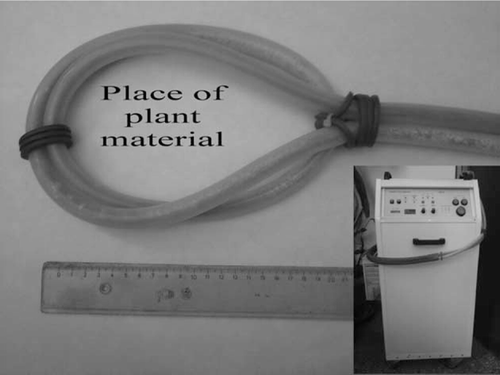Abstract
Many types of magnetic fields have already been investigated in order to find new methods to enhance plant growth. This study reports the positive effect of pulsed electromagnetic field on the main root characteristics (fresh weight, dry weight, root surface and length) of unrooted oregano stem cuttings. For oregano, vegetative propagation is commonly used, with rooted or unrooted stem cuttings, because seed propagation is not suggested for commercial cultivation. Oregano seeds are very small and, thus, difficult to handle. Vegetative reproduction in organic cultivation faces the ethical problem of the use of hormones to induce the rooting process in propagation beds. The purpose of this study was to determine if magnetic field can replace hormones in plant propagation and what the results of the combination of both magnetic field and hormones would be. Two types of stem cuttings were used (apical and middle) and the experiment was established in two different seasons (spring and autumn). The findings showed that magnetic field alone stimulates the rooting process in plant material, with results similar to or even statistically significantly better than those obtained using hormones. However, the combination of magnetic field and hormones resulted in measurements statistically significantly lower than with magnetic field alone. Such methods can potentially be useful for plant materials growers, providing better oregano seedlings, especially in organic farming, where chemical compounds are forbidden.
Introduction
The influence of magnetic fields on plants is a relatively new area in agricultural studies. In the last three decades, many studies have reported that magnetic fields have a positive impact on plants, as well as on animals and humans. It is generally agreed that the effect of magnetic fields on the growth of plants is focused on the increased germination rate of seeds (Aladjadjiyan, Citation2003), the enhancing of growth in early stages (Cakmak et al., Citation2010) and an increase in the yields of crops (Phirke et al., Citation1996). Such characteristics are absolutely desirable in modern agriculture, as well as in organic agriculture, because they are achieved with environmentally friendly methods and they are not expensive.
Different types of magnetic fields (static, electromagnetic, pulsed electromagnetic), at different levels of field strength and duration of exposure have been used to investigate the influence on plants. The results have shown both positive (Eşitken & Turan, Citation2004), and negative (Brulfert et al., Citation1985) effects. Magnetic fields have been reported to improve growth and development of tomato (De Souza et al., Citation2006), seed germination and early growth characteristics in sunflower (Vashisth & Nagarajan, Citation2010) and primary root growth of corn seedlings growing under constant influence of an alternating magnetic field (Muraji et al., Citation1998). Exposure of maize seeds to a 150 mT magnetic field stimulated shoot development in the early stages and led to an increase in germination, fresh weight and shoot length of maize plants (Aladjadjiyan, Citation2002). Pulsed electromagnetic fields (PEMFs) have also been successfully used in promoting wound healing in rats(Athanasiou et al., Citation2007). PEMFs can be produced by a PAPIMI, a device that has been used in similar studies (Milgram et al., Citation2004).
Oregano (Origanum vulgare L. ssp. hirtum) is a medicinal and aromatic plant found growing wild in the western Mediterranean. The rising demand for oregano worldwide in recent years has led to its commercial cultivation. Its secondary metabolites have functionally important properties that are very useful for food industry applications. The major component of the commercial essential oil of oregano is a monoterpenoid phenol, carvacrol which was found at levels as high as 60–75% (Fleisher & Sneer, Citation1982; Harvala et al., Citation1987).
Oregano is usually propagated vegetatively with rooted or unrooted stem cuttings (Kuris et al., Citation1981). Seed propagation is not suggested for commercial cultivation because of the low germination rate, especially of material originating from the wild, the heterogeneity of young plants and the considerable delay in yield production (Kuris et al., Citation1980; Putievsky et al., Citation1987). Hormonal treatment is a common tactic used to boost the rooting progress in order to achieve better establishment in the field. Indole butyric acid (IBA) increases both the number of roots per cutting and the rate of root formation in labiate plants (Kuris et al., Citation1980).
Starch is the main carbon-storage molecule of plants and the main source of energy. One of the most important enzymes for starch degradation is amylase. Recent studies have found higher α-amylase activity in seeds treated with a magnetic field (Vashisth & Nagarajan, Citation2010).
The application of magnetic field treatment in agricultural practice may provide many benefits in organic agriculture. The stimulation it offers in the early growth stages and in the rooting process is especially crucial to organic agriculture. This method can bypass the necessity for chemical compounds used in conventional agriculture and follows modern organic farming trends. Such techniques have already been investigated in organic practices of seedling production (Bilalis et al., Citation2009).
There is little published research on the effect of magnetic fields on plant materials such as unrooted stem cuttings that are widely used in plant propagation of some species. The aim of this study was to investigate the effect of PEMFs on the rooting process of unrooted oregano stem cuttings.
Materials and methods
Plant material
A greenhouse experiment was established at the Agricultural University of Athens (Greece), in spring 2006 and repeated in autumn 2006. Unrooted stem cuttings, 10 cm in length, were collected from plants of Origanum vulgare L. subsp. hirtum (Link) Ietsw. (syn. Origanum heracleoticum L.) cultivated in the field of the university. Two types of stem cuttings were used: apical stem cuttings and middle stem cuttings. Leaves from the basal section (3 cm) of the cuttings were removed.
Treatments
Magnetic field treatment (PEMF). These cuttings were treated using a PAPIMI electromagnetic field generator for 30 minutes immediately before planting (PAPIMI model 600; Pulse Dynamics, Athens, Greece. Manufacturer characteristics: 35–80 J/pulse, 1×10-6 s wave duration, 35–80×106 W wave power, amplitude of the order of 12.5 mT, rise time 0.1 ms, fall time 10 ms, repetitive frequency of 3 Hz; ). PAPIMI is certified for its conformity to the European directive MDD 93/42/EEC regarding the manufacturing of medical devices.
Hormonal treatment (H). The basal 3 cm of each untreated cutting was dipped for 5 s in water and then for 2 s in dusting powder of ROOTON A (IBA, 0.2% w/w, by SEGE, Athens, Greece).
Magnetic field and hormonal treatment (PEMF +H). In this treatment, cuttings were treated with both PEMF and hormone as described above. Cuttings were treated with hormone before PEMF treatment.
Planting
For the PEMF-treated cuttings, 2 ml Trichomic (Trichoderma sp., Trichodex Co. AMC Chemicals, Dos Hermanas, Spain), which is an organic fungicide, was used. For the H- and PEMF-H-treated cuttings, Daconil 75 WP (chlorothalonil, 75% w/w; Syngenta Crop Protection, Athens, Greece) was used. After the antifungal treatment, the cuttings were planted in propagation beds of 20 cells each. Every cell was 8×8 cm wide and was filled with substrate mixture (peat:perlite 1:1). After the planting, the propagation beds were maintained in a heated greenhouse. The experiment followed a completely randomized design, with three main treatments (MF, H and MF-H) and two subtreatments (apical and middle stem cuttings), with 20 replications.
Measurements and observations
Root samples were taken on 1 June 2006, 51 days after planting, for the first experiment (spring 2006), and on 15 February 2006, 91 days after planting, for the second experiment (autumn 2006). Each root sample was cleaned of peat and perlite medium by washing the samples over a 5 mm mesh sieve. A formalin/acetic acid/alcohol (FAA) staining solution was used. The determination of root length (RL) and root surface (RS) was made in millimeters by a high resolution scanner, using DT-software (Delta-T Scan version 2.04; Delta Devices Ltd, Burwell, Cambridge, UK) The fresh weight (FW) was measured by a precision balance and then the samples were oven dried at 70 °C for 3 days in order to measure the dry weight (DW) in grams per plant.
Field adoption
At the end of each experiment, rooted stem cuttings were transplanted in the field of the Agricultural University of Athens in order to calculate the percentage of successful transplantation. The soil was a clay loam (29.8% clay, 34.3% silt and 35.9% sand) with pH of 7.24 (the pH was determined in a 1:1 soil:H2O mixture), 1.17% organic matter and electrical conductivity of 0.54 mS cm−1.
Statistical analysis
The experimental data were analysed using the software Statistica (StatSoft, Citation1996), according to the completely randomized design. Differences among the means were compared using the Student-Newman-Keul (SNK) test, at the 5% level of significance.
Results
The investigation of the effect of electromagnetic fields on different unrooted oregano stem cuttings showed some statistically significant differences in the main root characteristics. Electromagnetic field exposure stimulated rooting processes. Furthermore, middle stem cuttings performed better than apical cuttings in both seasons (spring and autumn). PEMF application caused increases in root weight, root surface and root length.
Magnetic field improved root fresh weight (FW) and performed equal or better results with hormonal treatments. The highest fresh weight was found in the PEMF application (middle stem cuttings: 34.3 and 26.9 g plant−1 for spring and autumn 2006, respectively, and apical stem cuttings: 20.4 and 24.6 g plant−1 for spring and autumn 2006, respectively). The lowest FW was recorded with PEMF-H treatment. There were significant differences at the 5% significance level between PEMF and PEMF-H treatments concerning FW for both cutting types and in both seasons. PEMF treatment alone gave significantly higher fresh weight than H treatment for apical stem cuttings in spring 2006 ().
Figure 2. Effect of magnetic field (PEMF: Pulsed electromagnetic field, H: hormone, PEMF+H: Pulsed electromagnetic field and hormone) on fresh weight (g per plant) of rooted oregano cuttings. Means followed by the same letter for treatments are not significantly different according to the Student-Newman-Keul (SNK) test.
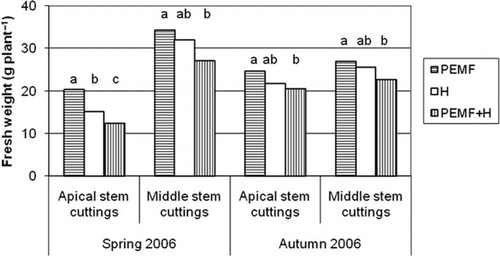
Dry weight was also higher with the PEMF treatment. The results show a statistically significant difference between magnetic field and hormone, especially in apical stem cuttings. The highest DW was observed in PEMF-treated cuttings (middle stem cuttings: 3.6 and 3.62 g plant−1 for spring and autumn 2006, respectively, and apical stem cuttings: 2.2 and 3.04 g plant−1 for spring and autumn 2006, respectively). There were significant differences at the 5% significance level between PEMF and PEMF-H treatments concerning DW, again for both cutting types and both seasons. PEMF treatment alone gave significantly higher dry weight than H treatment for apical stem cuttings ().
Figure 3. Effect of magnetic field (PEMF: Pulsed electromagnetic field, H: hormone, PEMF+H: Pulsed electromagnetic field and hormone) on dry weight (g per plant) of rooted oregano cuttings. Means followed by the same letter for treatments are not significantly different according to the Student-Newman-Keul (SNK) test.
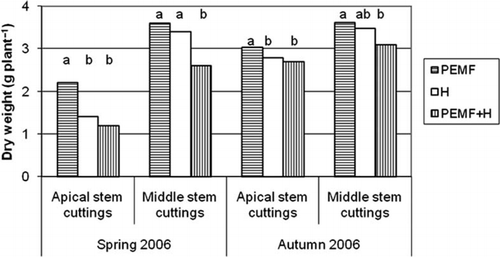
Electromagnetic field treatment enhanced the rooting process causing higher root surface (RS). The best results in RS measurements were obtained by far in spring 2006, in middle stem cuttings. In both seasons, the highest RS was found in middle stem cuttings, under PEMF treatment. For middle stem cuttings, the lowest RS was observed in PEMF-H-treated cuttings (1281 and 721 mm2 for spring and autumn 2006, respectively) and the highest in cuttings treated with PEMF alone (2640 and 1363 mm2 for spring and autumn 2006, respectively). There were significant differences between PEMF and the other treatments, in all cases, except middle stem cuttings in spring 2006. In the latter case, PEMF and H treatments gave similar results ().
Figure 4. Effect of magnetic field (PEMF: Pulsed electromagnetic field, H: hormone, PEMF+H: Pulsed electromagnetic field and hormone) on root surface (mm2 per plant) of rooted oregano cuttings. Means followed by the same letter for treatments are not significantly different according to the Student-Newman-Keul (SNK) test.
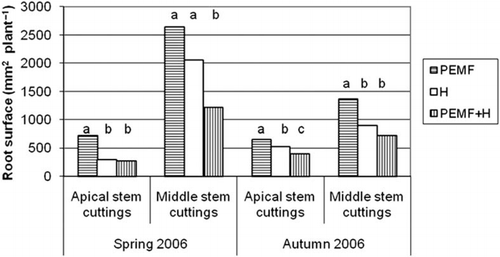
Application of electromagnetic field considerably increased root length (RL) of the cuttings. The highest values were recorded in middle stem cuttings, in both seasons, with PEMF treatments (middle stem cuttings: 2927 and 2182 mm for spring and autumn 2006 respectively, and apical stem cuttings: 1122 and 1863 for spring and autumn 2006, respectively). There were significant differences at the 5% significance level between PEMF and PEMF-H treatments concerning RL for both cutting types and seasons. PEMF treatment alone gave significantly higher RL than H treatment for apical and middle stem cuttings in spring 2006 and apical stem cutting in autumn 2006 ().
Figure 5. Effect of magnetic field (PEMF: Pulsed electromagnetic field, H: hormone, PEMF+H: Pulsed electromagnetic field and hormone) on root length (mm per plant) of rooted oregano cuttings. Means followed by the same letter for treatments are not significantly different according to the Student-Newman-Keul (SNK) test.
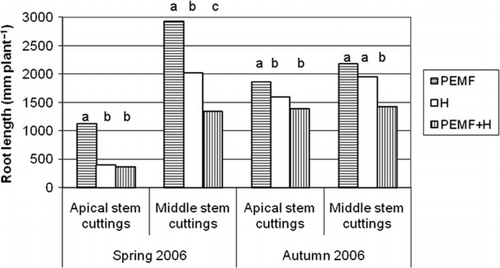
Finally, the transplanting of the rooted oregano stem cuttings in the field, under real conditions, showed a high viability of between 85–95% for all three treatments.
Discussion
The investigation of main root characteristics in this experiment showed that PEMF has a positive impact on RS and RL similarly to hormone treatment. These findings are very useful for organic practices replacing chemical compounds. Root characteristics in organic grown seedlings are widely investigated in order to serve the needs of rising demand in organic agriculture.
Hormones are widely used to enhance rooting of both softwood and hardwood cuttings. The rooting process in stem cuttings of aromatic plants has been reported to be dramatically increased by pre-treatment of cuttings with IBA (El-Keltawi & Croteau, Citation1986). In oregano, a range of IBA and indole acetic acid concentrations have been linked with increased root emergence (Kuris et al., Citation1981) and the number of roots per cutting (Kuris et al., Citation1980).
Storage starch is very important to plants and is broken down following specific seasonal or development cues, such as the beginning of spring in roots and bark (Stanley et al., Citation2005). Magnetic fields have been found to increase amylase activity (Vashisth & Nagarajan, Citation2010), improving the starch metabolism into soluble substrates.
Middle stem cuttings gave higher values of parameters in both seasons, and these results are in accordance with those obtained by other researchers. Fege and Brown (Citation1984) evaluated dormant hardwood poplar cuttings and reported the highest carbohydrate content in cuttings from basal portions of stool plants. High concentrations of carbohydrates are often associated with increased survival and root system production (Nguyen et al., Citation1990). Furthermore, there is a general trend for improved survival and root growth when cuttings originate close to the base of the plant (Hartmann et al., Citation1997). Carbohydrate content in poplar has been found to be higher in December and lower in September and May (Fege & Brown, Citation1984). This could explain the fact that the middle stem cuttings of spring 2006 performed better.
Root length and fresh weight in mint have been found to be affected by the type of cutting used. Higher values were obtained with middle stem cuttings and the lower values with apical stem cuttings (El-Keltawi & Croteau, Citation1986). The improved rooting from middle cuttings may have been the result of increased carbohydrate reserves stored in the larger-diameter cuttings (Hartmann et al., Citation1997). In addition, Signor et al. (Citation2007) reported that the oregano cuttings formed from apical region of the stem showed the highest rooting rate (98.3%) and they showed the greatest fresh and dry weight of shoots and roots.
The interaction between PEMF and H had no positive effect on the main root characteristics. De Souza et al. (Citation2008) observed that the magnetic treatments derived a significant increase of root length in lettuce plants derived from magnetically treated seeds. Moreover, magnetic fields have been found to affect chemical compounds (Nakagaki et al., Citation1997) such as synthetic hormones, as well as processes in chemical systems (Schulten, Citation1982).
The results presented here reveal that the exposure of unrooted oregano stem cuttings to pulsed electromagnetic field had a positive effect on root fresh and dry weight, root surface and root length. Magnetic fields may be of use in organic agriculture and be able to replace chemical hormones that are widely used in conventional agriculture. In organic agriculture, it is very important to ensure optimal growth characteristics, especially in early growth stages. Middle stem cuttings collected from oregano plants in early spring could give the best results in commercial production of oregano transplants.
References
- Aladjadjiyan , A. 2002 . Study of the influence of magnetic field on some biological characteristics of Zea mays . Journal of Central European Agriculture , 3 : 89 – 94 .
- Aladjadjiyan , A. 2003 . Influence of stationary magnetic field on the early stages of the development of tobacco seeds (Nicotiana tabacum L.) . Journal of Central European Agriculture , 4 : 131 – 138 .
- Athanasiou , A. , Karkambounas , S. , Batistatou , A. , Lykoudis , E. , Katsaraki , A. , Kartsiouni , T. , Papalois , A. and Evangelou , A. 2007 . The effect of pulsed electromagnetic fields on secondary skin wound healing: An experimental study . Bioelectromagnetics , 28 : 362 – 368 .
- Bilalis , D. , Kanatas , P. , Patsiali , S. , Konstantas , A. and Akoumianakis , K. 2009 . Comparison between conventional and organic floating systems for lettuce and tomato (Lactuca sativa and Lycopersicon esculentum) seedling production . Journal of Food Agriculture and Environment , 7 : 623 – 628 .
- Brulfert , A. , Miller , M. W. , Robertson , D. , Dooley , D. A. and Economou , P. 1985 . A cytohistological analysis of roots whose growth is affected by a 60-Hz electric field . Bioelectromagnetics , 6 : 283 – 291 .
- Cakmak , T. , Dumlupinar , R. and Erdal , S. 2010 . Acceleration of germination and early growth of wheat and bean seedlings grown under various magnetic field and osmotic conditions . Bioelectromagnetics , 31 : 120 – 129 .
- De Souza , A. , Garcí , D. , Sueiro , L. , Gilart , F. , Porras , E. and Licea , L. 2006 . Pre-sowing magnetic treatments of tomato seeds increase the growth and yield of plants . Bioelectromagnetics , 27 : 247 – 257 .
- De Souza , A. , Sueiro , L. , Gonzalez , L. M. , Licea , L. , Porras , E. P. and Gilart , F. 2008 . Improvement of the growth and yield of lettuce plants by non-uniform magnetic fields . Electromagnetic Biology and Medicine , 27 : 173 – 184 .
- EEC/93/42 1993 . European Council Directive concerning medical devices . EuroLex, Brussels. L0042/EN/20.11.2003/004.001/1 .
- El-Keltawi , N. and Croteau , R. 1986 . Single-node cuttings as a new method of mint propagation . Scientia Horticulturae , 29 : 101 – 105 .
- Eşitken , A. and Turan , M. 2004 . Alternating magnetic field effects on yield and plant nutrient element composition of strawberry (Fragaria×ananassa cv. camarosa) . Acta Agriculturae Scandinavica, Section B – Plant Soil Science , 54 : 135 – 139 .
- Fege , A. S. and Brown , G. N. 1984 . Carbohydrate distribution in dormant Populus shoots and hardwood cuttings . Forest Science , 30 : 999 – 1010 .
- Fleisher , A. and Sneer , N. 1982 . Oregano spices and Origanum chemotypes . Journal of the Science of Food and Agriculture , 33 : 441 – 446 .
- Hartmann , H. T. , Kester , D. E. , Davies , F. T. J. R. and Geneve , R. L. 1997 . Plant Propagation: Principles and Practices , 6th Edn , Upper Saddle River, NJ : Prentice Hall .
- Harvala , C. , Menounos , P. and Argyriadou , N. 1987 . Essential oil from Origanum dictamnus . Planta Medica , 53 : 107 – 109 .
- Kuris , A. , Altman , A. and Putievsky , E. 1980 . Rooting and initial establishment of stem cuttings of oregano, peppermint and balm . Scientia Horticulturae , 13 : 53 – 59 .
- Kuris , A. , Altman , A. and Putievsky , E. 1981 . Vegetative propagation of spice-plants: root formation in oregano stem cuttings . Scientia Horticulturae , 14 : 151 – 156 .
- Milgram , J. , Shahar , R. , Levin-Harrus , T. and Kass , P. 2004 . The effect of short high-intensity magnetic field pulses on the healing of skin wounds in rat . Bioelectromagnetics , 25 : 271 – 277 .
- Muraji , M. , Asai , T. and Tatebe , W. 1998 . Primary root growth rate of Zea mays seedlings grown in an alternating magnetic field of different frequencies . Bioelectrochemistry and Bioenergetics , 44 : 271 – 273 .
- Nakagaki , R. , Yamaoka , M. , Takahira , O. , Hiruta , K. , Fujiwara , Y. and Tanimoto , Y. 1997 . Magnetic field and isotope effects on photochemistry of chain-linked compounds containing benzophenone and hydrogen-donor moieties . Journal of Physical Chemistry A , 101 : 556 – 560 .
- Nguyen , P. V. , Dickmann , D. I. , Pregitzer , K. S. and Hendrick , R. 1990 . Late-season changes in allocation of starch and sugar to shoots, coarse roots, and fine roots in two hybrid poplar clones . Tree Physiology , 7 : 95 – 105 .
- Phirke , P. S. , Kubde , A. B. and Umbargar , S. P. 1996 . The influence of magnetic field on plant growth . Seed Science and Technology , 24 : 375 – 392 .
- Putievsky , E. , Ravid , U. and Dudai , N. 1987 . Phenological and seasonal influences on essential oil of a cultivated clone of Origanum vulgare L . Journal of the Science of Food and Agriculture , 43 : 225 – 228 .
- Schulten , K. 1982 . Magnetic field effects in chemistry and biology . Advances in Solid State Physics , 22 : 61 – 83 .
- Signor , D. , Kowalski , A. P. de J. , Alves , M. A. , Lima , F. L. de. and Biasi , L. A. 2007 . Herbaceous cutting propagation of oregano . Scientia Agraria, Curitiba , 8 : 431 – 434 .
- Stanley , D. , Farnden , K. J. F. and MacRae , E. A. 2005 . Plant α-amylases: functions and roles in carbohydrate metabolism . Biologia Bratislava , 16 : 65 – 71 .
- StatSoft, Inc 1996 . STATISTICA for Windows (Computer program manual) . Tulsa, OK : StatSoft, Inc .
- Vashisth , A. and Nagarajan , S. 2010 . Effect on germination and early growth characteristics in sunflower (Helianthus annuus) seeds exposed to static magnetic field . Journal of Plant Physiology , 167 : 149 – 156 .
